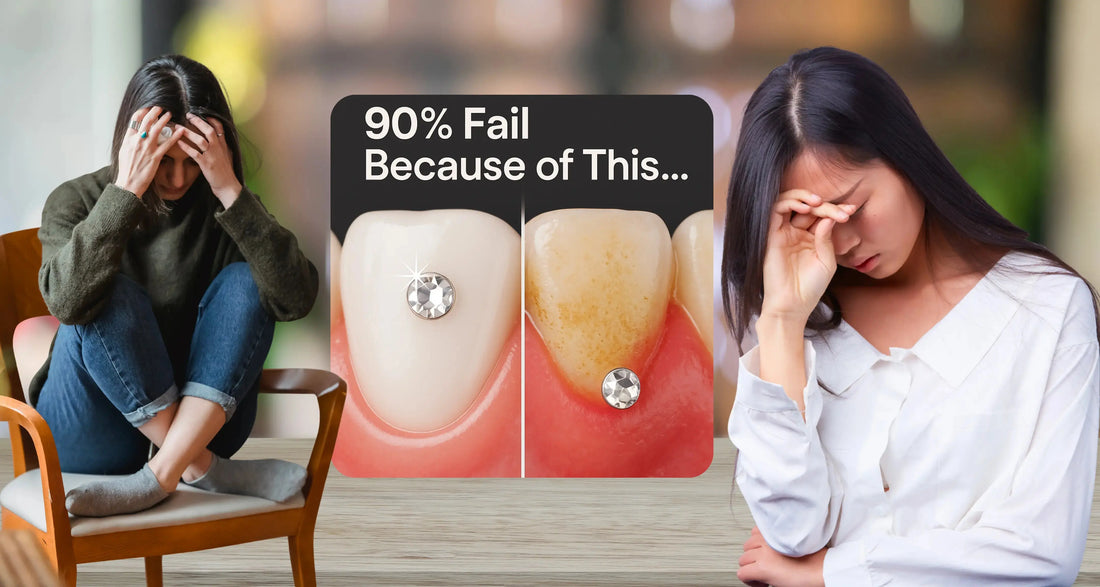
Why 90% of Tooth Gem Failures Start with Poor Oral Hygiene?
Share
A comprehensive guide to preventing tooth gem failures through proper oral hygiene protocols
Introduction
Tooth gems have become a popular cosmetic dental trend, but what many practitioners overlook is that the majority of application failures can be attributed to one critical factor: inadequate oral hygiene preparation.
Understanding this connection is essential for any tooth gem professional who wants to ensure long-lasting results and maintain client satisfaction.
The Hidden Truth About Tooth Gem Failures
When tooth gems fall off prematurely, crack, or cause complications, the first instinct is often to blame the adhesive, application technique, or even the gem quality.
Extensive industry experience reveals that oral hygiene issues are responsible for approximately 90% of tooth gem failures.
This statistic isn't just about basic cleanliness; it encompasses the entire spectrum of oral health conditions that can compromise the bonding process and longevity of tooth gems.
Read Also: Don't Let Your Tooth Gems Fall Off Again
Understanding the Science behind Adhesion
How Tooth Gems Bond to Teeth
Tooth gems rely on a chemical bond between the dental adhesive and the tooth enamel.
This process requires:
- Clean enamel surface: Free from plaque, tartar, and debris
- Proper pH levels: Balanced oral environment for optimal bonding
- Adequate moisture control: Neither too dry nor too wet
- Healthy tooth structure: Strong, intact enamel without decay
Why Poor Oral Hygiene Disrupts This Process
When oral hygiene is compromised, several factors interfere with proper adhesion:
- Bacterial biofilm formation: Creates a barrier between the adhesive and the enamel
- Acidic oral environment: Weakens both natural tooth structure and adhesive bonds
- Inflammation and bleeding: Introduces moisture and contaminants during application
- Plaque accumulation: Provides an unstable foundation for gem placement
Get the idea on this: DIY Tooth Gem Kit: Easy Steps to apply
The 5 Most Common Oral Hygiene Issues That Cause Failures
1. Inadequate Plaque Removal
The Problem: Visible or microscopic plaque on the tooth surface prevents proper adhesive penetration.
The Impact: Gems may appear to bond initially but fail within days or weeks as the plaque layer breaks down.
The Solution: Thorough professional cleaning before any gem application, including scaling if necessary.
2. Gingivitis and Gum Inflammation
The Problem: Inflamed gums bleed easily and create a contaminated work environment.
The Impact: Blood and inflammatory fluids compromise the sterile field needed for optimal bonding.
The Solution: Address gum health before gem placement and use proper isolation techniques.
3. Dry Mouth (Xerostomia)
The Problem: Insufficient saliva production leads to bacterial overgrowth and poor oral pH balance.
The Impact: Creates an environment where adhesives don't perform optimally and bacterial complications are more likely.
The Solution: Identify underlying causes and implement appropriate treatment protocols.
4. Poor Daily Oral Hygiene Habits
The Problem: Clients who don't maintain proper brushing and flossing routines.
The Impact: Rapid plaque accumulation around the gem site leads to premature failure and potential complications.
The Solution: Comprehensive aftercare education and follow-up protocols.
5. Existing Dental Conditions
The Problem: Untreated cavities, worn enamel, or previous dental work in the application area.
The Impact: Compromised tooth structure cannot support long-term gem retention.
The Solution: Thorough dental assessment and treatment of underlying issues before gem placement.
Read Also: What Is a Wax Pen & How to Use It for Tooth Gems
The Pre-Application Oral Hygiene Protocol
Step 1: Comprehensive Oral Assessment
Before any tooth gem procedure, conduct a thorough evaluation including:
- Visual inspection of all teeth and gums
- Assessment of overall oral hygiene status
- Identification of any contraindications
- Documentation of existing dental work or conditions
Step 2: Professional Cleaning
Implement a standardized cleaning protocol:
- Plaque scoring: Document baseline plaque levels
- Scaling and polishing: Remove all calculus and surface stains
- Fluoride treatment: Strengthen enamel if needed
- Antimicrobial rinse: Reduce bacterial load
Step 3: Site-Specific Preparation
For the gem placement area:
- Thorough debridement: Remove all plaque and debris
- Acid etching: Create optimal surface for bonding
- Isolation: Maintain dry, contamination-free environment
- Final inspection: Ensure perfect preparation before application
Client Education: The Key to Long-Term Success
Pre-Treatment Education
Educate clients about:
- The importance of good oral hygiene for gem longevity
- How poor oral health can lead to complications
- The need for professional cleaning before application
- Realistic expectations based on their current oral health status
Post-Treatment Care Instructions
Provide detailed aftercare guidelines including:
- Daily oral hygiene routine: Specific brushing and flossing techniques around gems
- Dietary recommendations: Foods and beverages to avoid
- Follow-up schedule: When to return for checkups
- Warning signs: When to seek immediate attention
Professional Best Practices
Screening and Consultation
Never compromise on the screening process:
- Refuse service to clients with active oral infections
- Require professional cleaning within 48 hours of application
- Document all oral health conditions and client education provided
- Obtain written consent acknowledging oral hygiene requirements
Ongoing Education and Training
Stay current with:
- Latest research on dental adhesives and oral health
- Updated protocols for infection control
- Advanced techniques for difficult cases
- Client communication strategies
The Business Impact of Poor Oral Hygiene
Financial Consequences
Poor oral hygiene preparation leads to:
- Higher failure rates: More warranty claims and repeat procedures
- Reduced client satisfaction: Negative reviews and lost referrals
- Legal liability: Potential complications and claims
- Increased costs: Time and materials for corrective procedures
Reputation Management
Maintaining high standards for oral hygiene:
- Builds trust with clients
- Establishes professional credibility
- Reduces negative feedback
- Creates positive word-of-mouth marketing
Advanced Techniques for Challenging Cases
Working with Compromised Oral Health
When clients have less-than-ideal oral health:
- Extended preparation time: Allow extra time for thorough cleaning
- Staged treatment approach: Address health issues first, gems second
- Modified aftercare protocols: More frequent follow-ups
- Clear communication: Set realistic expectations
Special Considerations
- Orthodontic patients: Unique challenges and protocols
- Smokers: Increased risk factors and modified care
- Medical conditions: Diabetes, autoimmune disorders, medications
- Age-related factors: Considerations for different age groups
Measuring Success: Key Performance Indicators
Tracking Failure Rates
Monitor these metrics:
- Immediate failures: Within 24-48 hours
- Short-term failures: Within 1-4 weeks
- Long-term retention: 3-6 months and beyond
- Complication rates: Infections, irritation, damage
Quality Improvement
Use data to:
- Identify patterns in failures
- Refine protocols and procedures
- Improve client screening processes
- Enhance training programs
Shop Now Our Professional Tooth Gem Kit Now!
Future Trends and Developments
Emerging Technologies
Stay informed about:
- Advanced adhesive systems: Improved bonding agents
- Diagnostic tools: Better assessment of oral health
- Preventive treatments: New approaches to oral hygiene
- Material innovations: Longer-lasting gem options
Industry Standards
Anticipate changes in:
- Regulatory requirements
- Professional certification standards
- Insurance and liability considerations
- Client expectations and demands
Conclusion
The connection between oral hygiene and tooth gem success cannot be overstated. By understanding that 90% of failures stem from poor oral hygiene preparation, professionals can dramatically improve their success rates, client satisfaction, and business outcomes.
The investment in proper oral hygiene protocols—including thorough assessment, professional cleaning, and comprehensive client education—pays dividends through reduced failure rates, enhanced reputation, and long-term client relationships.
Remember: every successful tooth gem application begins with a foundation of excellent oral hygiene. Make this principle the cornerstone of your practice, and watch your success rates soar while your complications plummet.
